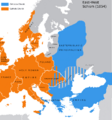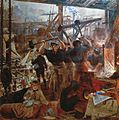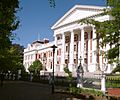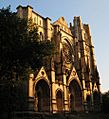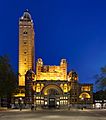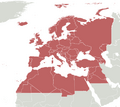Western world facts for kids
Western world has meant various things at various times. In the earliest history of europe it referred to Ancient Greece and the Aegean. During the Roman Empire, it meant the Western Roman Empire (covering the area from Croatia to Britain). At other times, it has meant Western Europe or Europe or Christendom. During the Cold War, it sometimes meant the democratic countries or those allied with the various NATO powers.
In this day and age, it often refers to the places that have a European heritage culture. This european heritage itself is a combination of, Judeo-Christian ethic, Classical Greco-Roman thinking and the cultural practices of the "barbarian" peoples of Northern Europe. Under the strictest definition, it would include North America, Australia and Western/Central Europe: with the identities of Latin America, Eastern Europe, the Philippines, Singapore, Israel and South Africa being disputed due to the mix of both western and non western culture.
Images for kids
-
In dark blue is the Western world (Australia, Canada, Catholic and Protestant Europe, New Zealand, plus the United States), based-on Samuel P. Huntington's 1996 Clash of Civilizations. In turquoise are Orthodox Europe and Latin America. For Huntington, Orthodox Europe is the eastern part of the Western world, while Latin America was part of the Western world or a descendant civilization that was twinned with it.
-
Gold and garnet cloisonné (and mud), military fitting from the Staffordshire Hoard before cleaning
-
The School of Athens depicts a fictional gathering of the most prominent thinkers of classical antiquity. Fresco by Raphael, 1510–1511
-
Map with the main travels of the Age of Discovery (began in 15th century).
-
The Roman Empire in AD 117. During 350 years the Roman Republic turned into an Empire expanding up to twenty-five times its area
-
The religious distribution after the East-West Schism of AD 1054.
-
Map of the Byzantine Empire in AD 1180 on the eve of the Latin Fourth Crusade.
-
Portuguese discoveries and explorations since 1336: first arrival places and dates; main Portuguese spice trade routes in the Indian Ocean (blue); territories claimed by King John III of Portugal (c. 1536) (green).
-
The Industrial Revolution, which began in Great Britain in 1760s and was preceded by the Agricultural and Scientific revolutions in the 1600s, forever modified the economy worldwide.
-
New York City has been a dominant global financial center since the 1900s.
-
The Western world based-on Samuel P. Huntington's 1996 Clash of Civilizations. Latin America, depicted in turquoise, could be considered a sub-civilization within Western civilization, or a distinct civilization intimately related to the West and descended from it. For political consequences, the second option is the most adequate.
-
Division of the Roman Empire after 395 into western and eastern part. The geopolitical divisions in Europe that created a concept of East and West originated in the Roman Empire.
-
Countries with 50% or more Christians are colored purple while countries with 10% to 50% Christians are colored pink
-
Human language families.
-
Western Palearctic, a part of the Palearctic realm, one of the eight biogeographic realms dividing the Earth's surface.
-
Relative geographic prevalence of Christianity versus the second most prevalent religion Islam and lack of either religion, in 2006.
See also
 In Spanish: Occidente para niños
In Spanish: Occidente para niños







